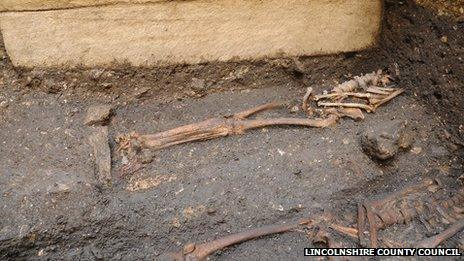Unknown church beneath Lincoln Castle is 'major find'
- Published

Skeletons thought to date from the Anglo-Saxon period were also found
A previously undiscovered church, thought to be at least 1,000 years old, has been found beneath Lincoln Castle.
It is believed the stone church was built in the Anglo-Saxon period, after the Romans left Britain and before the Norman conquest of 1066.
Lincolnshire County Council said the find was unexpected and will increase its knowledge of uphill Lincoln.
Human skeletons were also found in the same area three metres (9.8 ft) below the surface.
The area was being excavated by archaeologists before the construction of a lift shaft as part of a revamp of the castle.
Beryl Lott, historic environment manager for Lincolnshire County Council, said: "The [church] discovery was totally unexpected, but it is well known that other Roman walled towns often contained some high-status use during the Anglo-Saxon period.
"It's a major find and we look forward to future developments."
'Pretty rare'
A skeleton laid inside a niche in the wall foundation has also been found at the site.
The bones were wrapped in a finely woven textile and appeared to be a votive deposit, where the body was placed inside the wall to dedicate the building.
Radiocarbon dating will be used to try and refine the date of the remains which are expected to be from the 10th Century.
A endoscopic camera is also set to be used to explore a sealed limestone coffin.
Martin Carver, professor at the University of York, said: "The most important thing is to get a close look at what's inside.
"The Romans used sarcophagi, including Christian ones in the 4th Century, and the early Christian English re-used them in the 7th. But late Saxon stone coffins are pretty rare."
Lincolnshire County Council is preparing the castle for its rebirth as a major tourist attraction.
The finds will form part of an exhibition at the building.